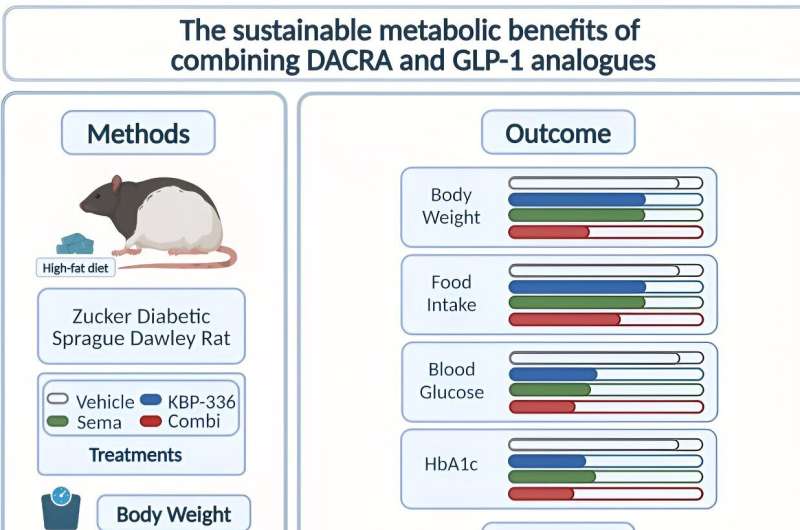
New research finds a combination of drugs improves weight loss, glucose control and insulin resistance better than either drug alone. Using two diabetes medications together, such as a semaglutide like Ozempic or Rybelsus, with a second, newer class of drug, may offer a noninvasive solution to help people with type 2 diabetes lose weight. This could also help them manage their condition without the need for bariatric surgery.
The study is published ahead of print in the American Journal of Physiology-Endocrinology and Metabolism. The work is titled “The enduring metabolic improvement of combining dual amylin and calcitonin receptor agonist and semaglutide treatments in a rat model of obesity and diabetes.”
Type 2 diabetes and obesity, particularly when they occur together, carry the long-term risk of cardiovascular disease. Studies have shown that losing at least 15% of a person’s body weight can improve metabolic factors associated with diabetes and reduce associated health risks.
Glucagon-like peptide-1 receptor agonists (GLP-1 analogs) medications such as semaglutide reduce blood sugar on their own. However, researchers are exploring newer treatments that combine different classes of drugs to improve weight loss and obesity-related conditions in people with type 2 diabetes. One of these additional drug classes is called dual amylin and calcitonin receptor agonists, or DACRAs.
In their study, researchers from Denmark studied a rat model of obesity and diabetes. For seven months, adult rats were treated with either semaglutide alone, a DACRA called KBP-336 alone or a combination of the two drugs.
During the first three months of the trial, all treatment groups lost a significant amount of weight. But in the latter half of the study, the combination group had a more sustained and continued weight loss than either of the single-drug treatment groups. The animals receiving the combination therapy also had less visceral fat. Visceral fat can be especially dangerous because it surrounds the organs and can affect how they function.
The research team found that the newer drug, KBP-336, was effective both alone and together with semaglutide, in stabilizing fasting blood sugar levels. It also reduced endotrophin—a product derived from collagen that is expressed in fat tissue. High endotrophin levels can be a marker for both heart and liver failure. The combination therapy also provided a measure of glucose tolerance and lower insulin levels than either drug alone.
“In obesity and type 2 diabetes, the treatment gap between pharmacotherapies and bariatric surgeries is narrowing: however, to finally bridge it, combination therapies are needed,” the researchers wrote. “Altogether, KBP-336 is a promising candidate for the treatment of obesity and type 2 diabetes both alone an in combination with GLP-1 analogs.”
More information:
Anna Thorsø Larsen et al, The enduring metabolic improvement of combining dual amylin and calcitonin receptor agonist and semaglutide treatments in a rat model of obesity and diabetes, American Journal of Physiology-Endocrinology and Metabolism (2024). DOI: 10.1152/ajpendo.00092.2024
Citation:
Combining two diabetes drugs helps promote weight loss and blood sugar control, rat study finds (2024, August 20)
retrieved 28 September 2024
from https://medicalxpress.com/news/2024-08-combining-diabetes-drugs-weight-loss.html
This document is subject to copyright. Apart from any fair dealing for the purpose of private study or research, no
part may be reproduced without the written permission. The content is provided for information purposes only.


